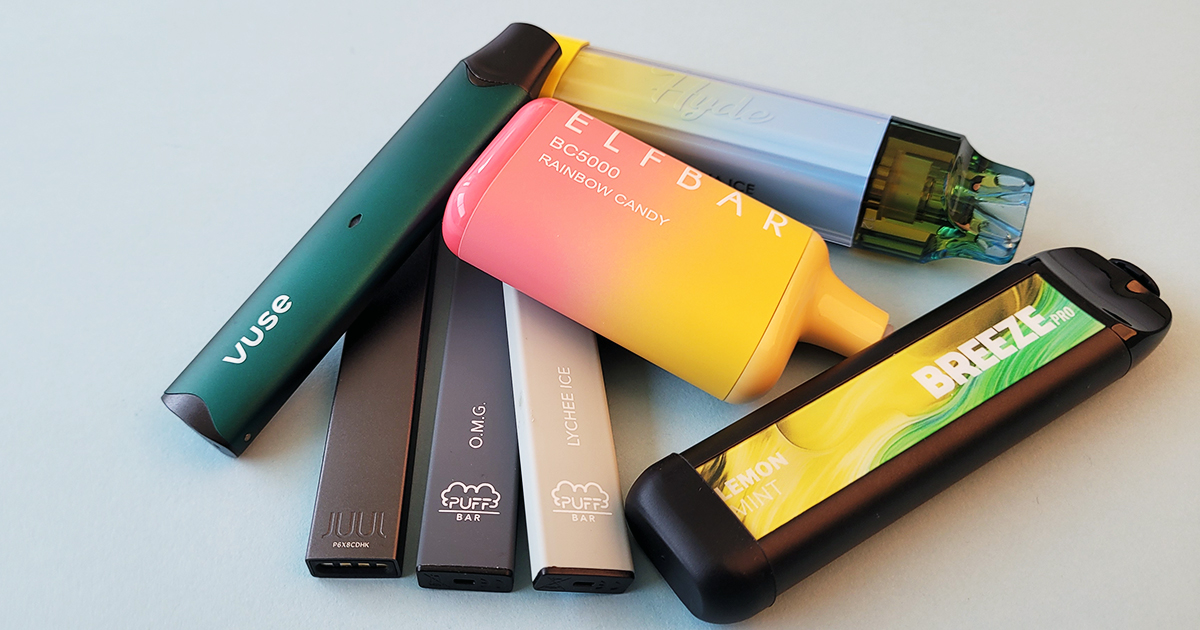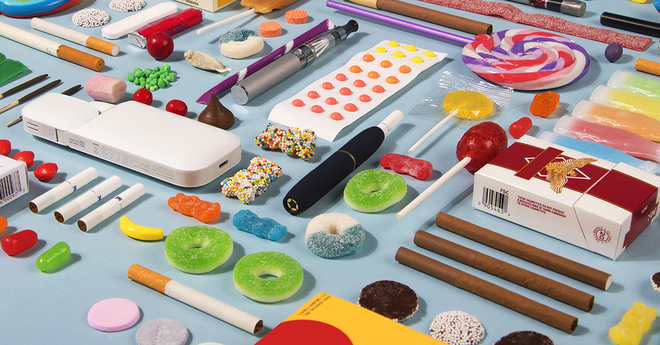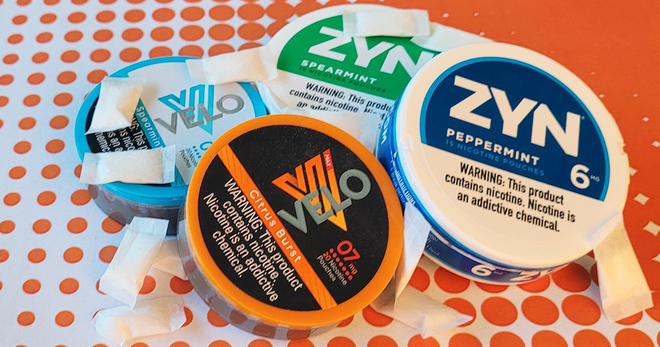Elf Bar, Hyde, and Breeze – what you need to know about the rise in disposable e-cigarettes
With flavors like cheesecake, bubble gum, and strawberry ice cream, disposable e-cigarettes – like top brand Puff Bar and similar products Elf Bar, Hyde, and Breeze – are popular among young people and have yet to face significant regulation, encouraging the rise of similar products.
These products are among the many sweet and fruity flavored e-cigarettes that remain on the market due to gaps in federal policy. Federal restrictions enacted in early 2020 only limit these types of flavors (excluding menthol) for “closed pod” e-cigarettes, like JUUL, and exempts other types, including disposable and open-system, refillable devices. Following their exemption, disposable e-cigarettes skyrocketed in popularity, with use increasing about 1,000% (from 2.4% to 26.5%) among high school e-cigarette users and more than 400% (from 3% to 15.2%) among middle school e-cigarette users during 2019-2020.

Many disposable e-cigarette manufacturers also began using synthetic nicotine – nicotine created in a laboratory and not derived from tobacco – to exploit another regulatory loophole that has allowed sweet and fruity flavored products to proliferate. When products containing synthetic nicotine first came onto the market, some companies claimed that they did not have to be regulated by the Food and Drug Administration (FDA). While this was not accurate, the FDA was slow to determine how it would regulate these products. Taking advantage of FDA’s hesitance, many e-cigarette makers that used tobacco-derived nicotine switched to synthetic nicotine to avoid regulatory oversight. For example, the makers of Puff Bar, which the FDA ordered to stop selling their flavored, tobacco-derived e-cigarette products in July 2020, returned to the market months later claiming to use synthetic nicotine. Puff Bar products remain on the market.
Congress closed the synthetic nicotine loophole in March, passing and signing into law language clarifying that synthetic nicotine products must be regulated by the FDA’s Center for Tobacco Products in the same way that tobacco-derived nicotine products are regulated. (Note: Some products that are considered drugs, such as Nicotine Replacement Therapies used to help people quit tobacco, are regulated under the Center for Drug Evaluation and Research and must go through CDER’s approval process for safety and effectiveness.) Despite the change in law, FDA has not followed the deadlines Congress laid out to remove these illegal synthetic nicotine e-cigarette products from the market. Because FDA is flouting the law, products that appeal to youth remain on the market and industry is emboldened to continue to flood the market with new flavors and products at will.
Both these product characteristics – being disposable and using synthetic nicotine – have helped allow sweet and fruity-flavored e-cigarettes to stay on the market. Here are some important things to know about Elf Bar, Hyde, Breeze, and similar products.
How much nicotine is in disposable e-cigarettes?
How much nicotine is in an Elf Bar
These types of disposable e-cigarettes can contain up to 5% nicotine by weight (50 mg/mL) – similar to Puff Bar – with some, including Hyde and Breeze, using a synthetic nicotine formula. Synthetic nicotine products are often marketed as “tobacco-free” and “healthier” and “better” than products containing tobacco-derived nicotine, potentially misleading consumers since the products still contain the addictive chemical nicotine.
Nicotine in any form is harmful to developing brains. Adolescent use can disrupt the formation of brain circuits that control attention, learning, and may make them more susceptible to addiction at a later age. Research has shown that early age of smoking and pleasurable initial experiences are correlated with daily use and a lifetime of nicotine dependence. Vaping nicotine can also intensify symptoms of depression and anxiety and increase stress levels.
What flavors do Elf Bar, Hyde, and Breeze come in?
Hyde rave flavors and Breeze Pro Flavors
They come in a variety of different flavors – from pineapple ice and lemon cookies to strawkiwi and blueberry watermelon. It is well established that flavors play a significant role in enticing youth and young adults to try and use tobacco products.
When regulation impacted the availability of many flavors in “closed pod” e-cigarettes, such as JUUL, young e-cigarette users switched to other brands still offering sweet and fruity flavors. Data from our This is Quitting text messaging program designed to help young people quit vaping showed that by the time a federal restriction on prefilled pod-based flavored e-cigarettes (excluding menthol) went into effect in February 2020, This is Quitting users had largely shifted away from JUUL to products from the brands Puff Bar and Smok. The most popular e-cigarette brands among 13-24-year-olds who enrolled in This is Quitting in 2022 are Puff Bar (23%), JUUL (8.4%), and Hyde (6.5%).
National data from the CDC Foundation reflect these market changes as well. From 2020 to 2021, the disposable e-cigarette market share grew from a quarter of the total e-cigarette market to more than one-third (from 25% to 37.5%).
What action is needed to address these flavored products?
Elf Bar 5000, Hyde Edge Rave, Breeze Pro Vape ban
Many e-cigarettes have been allowed to stay on the market for years without undergoing a review of their public health impact, sparking an epidemic of youth use.
On Sept. 9, 2021, the FDA finally faced a court-ordered deadline to review millions of premarket applications (known as PMTAs) from e-cigarette manufacturers to determine whether the products are “appropriate for the protection of public health.” The agency denied the applications of nearly a million flavored products, but almost a year after the FDA’s deadline, it has yet to act on many of the most popular products with young people. In fact, the agency has yet to complete reviews from the largest companies with the most popular products that make up over 75% of the e-cigarette market, despite the court-ordered September 2021 deadline to do so. In the months surrounding and following the deadline, nearly 1.5 million young people – including 800,000 teens between 15 and 18 years old – used an e-cigarette for the first time.
The agency must immediately prioritize completing its review of the top brands that make up the majority of the total e-cigarette market and are most popular among youth. The FDA must also use its Congressionally-mandated authority to address synthetic nicotine as part of this process so that leading disposable brands can no longer slip through this loophole.
More in emerging tobacco products
Want support quitting? Join EX Program
By clicking JOIN, you agree to the Terms, Text Message Terms and Privacy Policy.
Msg&Data rates may apply; msgs are automated.


